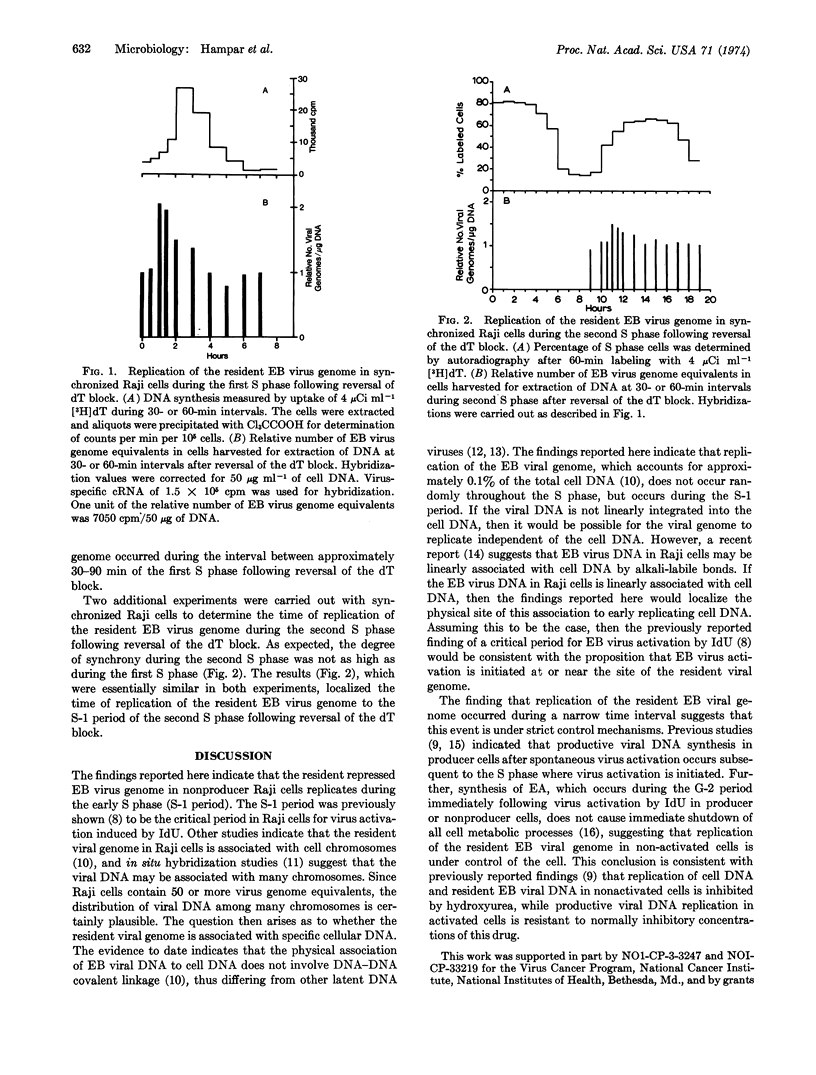Abstract
Replication of the resident repressed Epstein-Barr virus genome in synchronized nonproducer Raji cells was shown to occur during the early S phase (S-1 period) by hybridization of cell DNA with virus-specific complementary RNA (cRNA). The S-1 period was previously identified as the critical period for virus activation induced by thymidine analogues. The findings reported here and elsewhere are consistent with the proposal that: (i) virus activation is initiated at or near the site of association of the resident viral genome with cell DNA, (ii) replication of the resident virus genome in nonactivated cells is under cell control mechanisms, and (iii) the resident virus genome is physically associated with early replicating cell DNA.
Keywords: cell synchrony, provirus, nucleic acid hybridization
Full text
PDF


Selected References
These references are in PubMed. This may not be the complete list of references from this article.
- Adams A., Lindahl T., Klein G. Linear association between cellular DNA and Epstein-Barr virus DNA in a human lymphoblastoid cell line. Proc Natl Acad Sci U S A. 1973 Oct;70(10):2888–2892. doi: 10.1073/pnas.70.10.2888. [DOI] [PMC free article] [PubMed] [Google Scholar]
- Derge J. G., Martos L. M., Tagamets M. A., Chang S. Y., Chakrabarty M. Identification of a critical period during the S phase for activation of the Epstein-Barr virus by 5-iododeoxyuridine. Nat New Biol. 1973 Aug 15;244(137):214–217. doi: 10.1038/newbio244214a0. [DOI] [PubMed] [Google Scholar]
- Doerfler W. Integration of the deoxyribonucleic acid of adenovirus type 12 into the deoxyribonucleic acid of baby hamster kidney cells. J Virol. 1970 Nov;6(5):652–666. doi: 10.1128/jvi.6.5.652-666.1970. [DOI] [PMC free article] [PubMed] [Google Scholar]
- Gerber P. Activation of Epstein-Barr virus by 5-bromodeoxyuridine in "virus-free" human cells (complement-fixing antigen-immunofluorescence-leukocytes). Proc Natl Acad Sci U S A. 1972 Jan;69(1):83–85. doi: 10.1073/pnas.69.1.83. [DOI] [PMC free article] [PubMed] [Google Scholar]
- Hampar B., Derge J. G., Martos L. M., Tagamets M. A., Burroughs M. A. Sequence of spontaneous Epstein-Barr virus activation and selective DNA synthesis in activated cells in the presence of hydroxyurea. Proc Natl Acad Sci U S A. 1972 Sep;69(9):2589–2593. doi: 10.1073/pnas.69.9.2589. [DOI] [PMC free article] [PubMed] [Google Scholar]
- Hampar B., Derge J. G., Martos L. M., Walker J. L. Persistence of a repressed Epstein-Barr virus genome in Burkitt lymphoma cells made resistant to 5-bromodeoxyuridine. Proc Natl Acad Sci U S A. 1971 Dec;68(12):3185–3189. doi: 10.1073/pnas.68.12.3185. [DOI] [PMC free article] [PubMed] [Google Scholar]
- Hampar B., Derge J. G., Martos L. M., Walker J. L. Synthesis of Epstein-Barr virus after activation of the viral genome in a "virus-negative" human lymphoblastoid cell (Raji) made resistant to 5-bromodeoxyuridine (thymidine kinase-virus antigen-immunofluorescence-herpesvirus fingerprints). Proc Natl Acad Sci U S A. 1972 Jan;69(1):78–82. doi: 10.1073/pnas.69.1.78. [DOI] [PMC free article] [PubMed] [Google Scholar]
- Nonoyama M., Pagano J. S. Detection of Epstein-Barr viral genome in nonproductive cells. Nat New Biol. 1971 Sep 22;233(38):103–106. doi: 10.1038/newbio233103a0. [DOI] [PubMed] [Google Scholar]
- Nonoyama M., Pagano J. S. Homology between Epstein-Barr virus DNA and viral DNA from Burkitt's lymphoma and nasopharyngeal carcinoma determined by DNA-DNA reassociation kinetics. Nature. 1973 Mar 2;242(5392):44–47. doi: 10.1038/242044a0. [DOI] [PubMed] [Google Scholar]
- Nonoyama M., Pagano J. S. Separation of Epstein-Barr virus DNA from large chromosomal DNA in non-virus-producing cells. Nat New Biol. 1972 Aug 9;238(84):169–171. doi: 10.1038/newbio238169a0. [DOI] [PubMed] [Google Scholar]
- Sambrook J., Westphal H., Srinivasan P. R., Dulbecco R. The integrated state of viral DNA in SV40-transformed cells. Proc Natl Acad Sci U S A. 1968 Aug;60(4):1288–1295. doi: 10.1073/pnas.60.4.1288. [DOI] [PMC free article] [PubMed] [Google Scholar]
- Zur Hausen H., Schulte-Holthausen H. Presence of EB virus nucleic acid homology in a "virus-free" line of Burkitt tumour cells. Nature. 1970 Jul 18;227(5255):245–248. doi: 10.1038/227245a0. [DOI] [PubMed] [Google Scholar]
- zur Hansen H., Diehl V., Wolf H., Schulte-Holthausen H., Schneider U. Occurrence of Epstein-Barr virus genomes in human lymphoblastoid cell lines. Nat New Biol. 1972 Jun 7;237(75):189–190. doi: 10.1038/newbio237189a0. [DOI] [PubMed] [Google Scholar]


